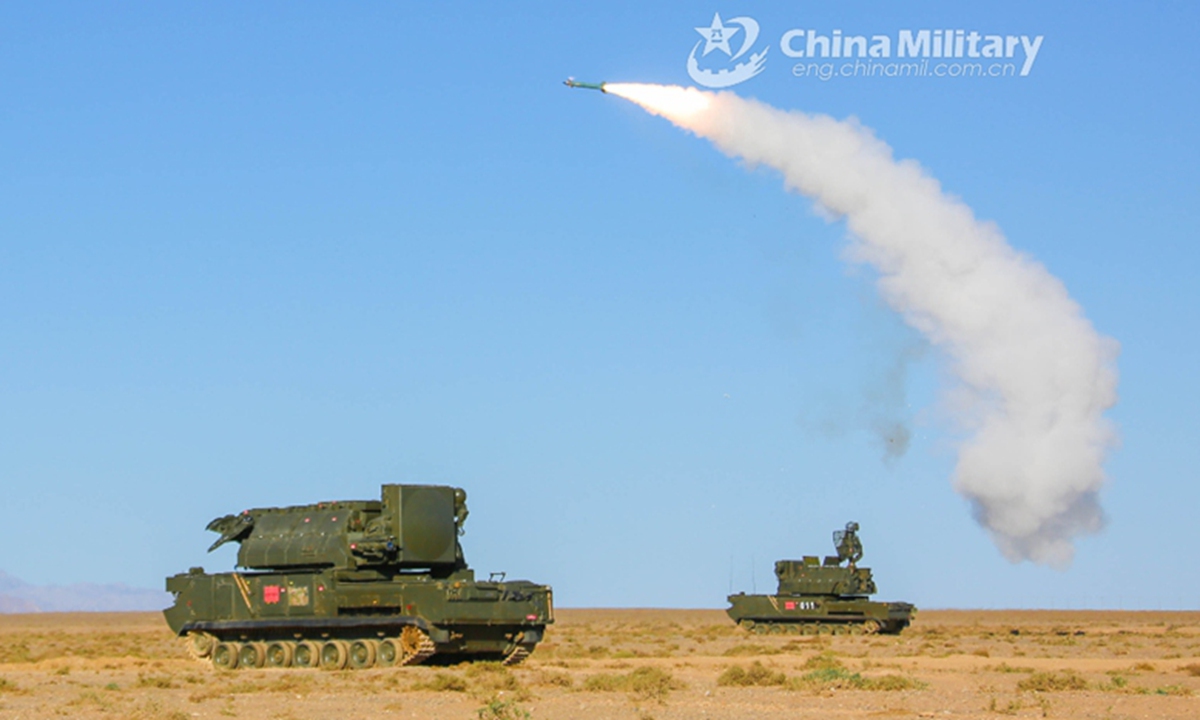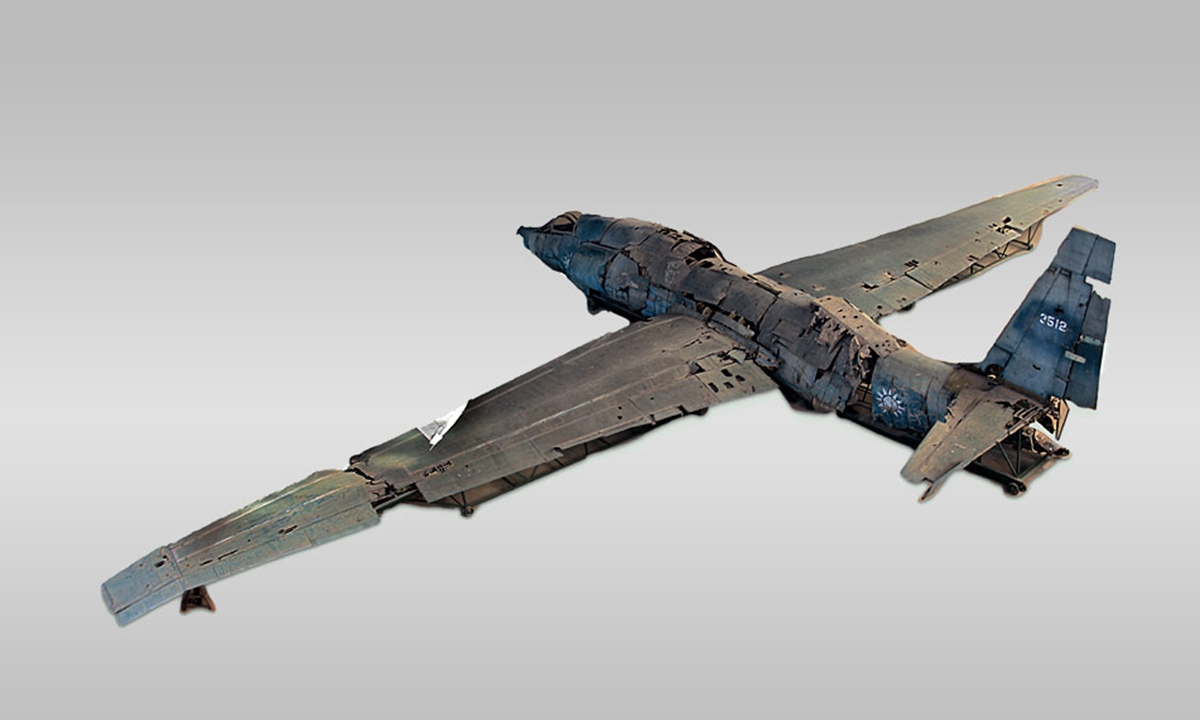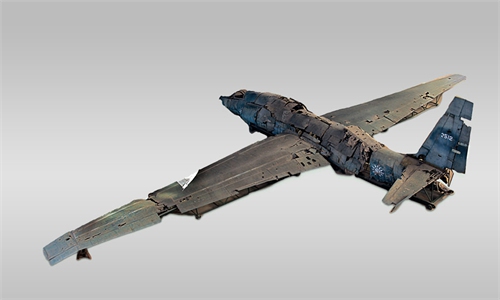
Armored vehicles mounted with Tor anti-aircraft missile systems attached to an air defense brigade under the PLA Eastern Theater Command fire at mock aerial targets during a whole-process live-fire test in northwestern China's Gobi desert on July 26, 2020. (eng.chinamil.com.cn/Photo by Wang Wenzhou)
By sending an RC-135S ballistic missile-detection plane to spy on Chinese People's Liberation Army (PLA) drills in the South China Sea on Wednesday, the US has deployed its spy aircraft to gather intelligence on two separate PLA exercises two days in a row, following another occasion on Tuesday that saw a U-2 high-altitude aircraft provocatively trespass into a no-fly zone of a live-fire drill by the PLA Northern Theater Command that risked a misfire accident.
China announced on Wednesday another navigation restriction zone for military exercises, a move providing transparency to the public and designed to send the US a clear message that the US would need to assume all responsibility if its reconnaissance aircraft got mistakenly shot down by the PLA should they conduct close-up reconnaissance on Chinese drills again, analysts said.
An RC-135S of the US Air Force, designed to gather data on ballistic missile launches, re-entry and electronic information, flew across the South China Sea on Wednesday morning, according to monitoring from the Beijing-based think tank the South China Sea Strategic Situation Probing Initiative (SCSPI) on the same day.
The aircraft crossed the Bashi Channel from the east, headed southwest into the South China Sea, and returned on the same route, according to a flight trajectory drawn by the SCSPI. It approached near an ongoing PLA exercise in waters off Hainan Island's southeast coast.
The PLA drills are being held in the waters from Monday to Saturday, according to a navigation restriction notice released on Friday by the Hainan Maritime Safety Administration, which did not provide further details regarding the drills.
It is possible that the US believes the PLA would launch anti-ship ballistic missiles like the DF-21D or the DF-26 in the drills, so it sent the RC-135S to gather intelligence, a Chinese military expert who requested anonymity told the Global Times on Wednesday.
The missiles are extremely threatening to US warships, particularly to its aircraft carriers, the expert said, noting that the US must be anxious and eager to find out how to counter them.
Fu Qianshao, a Chinese military aviation expert, told the Global Times on Wednesday that China is the only country in the world that has the technology to develop anti-ship ballistic missiles, and the US is eager to learn about China's methodology.
China usually tests ballistic missiles inland to keep confidential intelligence away from the prying eyes of other countries, and the PLA also has many other types of exercise subjects that it conducts in the South China Sea, so the ongoing drills do not necessarily feature anti-ship ballistic missiles. If the PLA drills did not feature ballistic missiles, the RC-135S can still attempt to gather intelligence on other types of weapons and equipment with its wide selection of sensors, Fu said.
The RC-135S's close-up reconnaissance of the PLA drills in the South China Sea came only one day after a US U-2 high-altitude reconnaissance aircraft trespassed into a no-fly zone that was hosting a live-fire drill by the PLA Northern Theater Command on Tuesday.
The U-2 incursion is a blatant, provocative act that could have easily caused misunderstanding and misjudgment, and even triggered an air and maritime accident, Chinese Foreign Ministry spokesperson Zhao Lijian said at a routine press conference on Wednesday.
When first making the announcement on Tuesday, Chinese Defense Ministry spokesperson Wu Qian also made similar statements to strongly denounce the dangerous move made by the US.

Wreckage of a US-made U-2 high-altitude reconnaissance aircraft is on display at the Military Museum of the Chinese People's Revolution in Beijing. The military on the island of Taiwan used U-2s to conduct reconnaissance missions on the Chinese mainland since January 1962, and the PLA Air Force shot down the first U-2 on September 9, 1962 in the suburbs of Nanchang, East China's Jiangxi Province. Photo: Military Museum of the Chinese People's Revolution
Chinese military experts said that the U-2 could have been mistakenly shot down by the PLA.
China has lodged solemn representations with the US, and demanded the US to stop such provocative acts immediately, Zhao said.
Amid the two provocative close-up reconnaissance operations from the US on PLA drills, China on Wednesday announced yet another set of live-fire military exercises.
The exercises will be held from Thursday to Sunday in the waters of the East China Sea, read a navigation restriction notice the Zhejiang Maritime Safety Administration released on Wednesday.
Giving the exact coordinates of the military exercise zone, the notice, released in both Chinese and English, said that any act of trespassing would be prohibited.
China openly introduced restriction zones for its drills, as setting similar zones are a common practice for many militaries around the world, including the US. This would leave the US with no excuse to trespass, and if it continues to do so, it should be the one that should be held accountable if any accident were to occur, analysts said.
According to a report by the Beijing Daily on Wednesday, China has held at least 22 military exercises in all of its four sea regions, namely the South China Sea, East China Sea, Yellow Sea and Bohai Sea, in the past month. All exercises were announced together with clearly formulated restriction zones.
Odds of misfire
While China did not announce many details regarding the exercises, Chinese military experts have predicted that many of them could feature anti-ship, air defense and anti-submarine drills.
In live-fire air defense exercises, anti-aircraft missiles and close-in weapon systems could be fired, and an aircraft suddenly appearing on radar could be mistaken for a training target, because in realistic drills, troops often do not know how the drills will transpire and can only rely on their own judgments to pass the tests, the above-mentioned expert said.
With an exercise zone being restricted, anything on radar that is not friendly is likely to be hostile, the expert said, noting that the PLA must have carefully identified the U-2 and exercised restraint not to let an accident happen, but US planes might not be so fortunate next time.
US aircraft could also accidentally stumble into the trajectory of target drones or PLA aircraft, which could risk collision and escalation, analysts said.
Unbearable consequences
The US keeps playing the dangerous game of testing China's bottom line and stirring up provocations as it is pushing for a cold war against China. But at the same time, the US does not want the 1962 Cuban Missile Crisis to repeat again since this time it could not bear the consequences, Lü Xiang, a research fellow at the Chinese Academy of Social Sciences in Beijing, told the Global Times on Wednesday.
US provocations against China would do nothing to solve its domestic problems. But the more severe domestic turmoil it suffers, the tougher it wants to act with the hope to deter strategic competitors and maintain dominance with its allies especially in Asia to keep the order it wants, Lü noted.
Aside from sending reconnaissance planes, US politicians and military officials also voiced tough rhetoric against China. For example, on Monday, US Secretary of Defense Mark Esper released an article in the Wall Street Journal headlined "the Pentagon Is Prepared for China." He also hyped up the PLA threat and said the US and its allies are ready to defend on every front.
Li Haidong, a professor at the Institute of International Relations at the China Foreign Affairs University, told the Global Times that Esper is repeating US mainstream strategies against China - attacking the Communist Party of China and the PLA, which are the cornerstones of ensuring China's security and stability.
Esper expressed on July 21 his hope to visit China within the year, which was interpreted by some media as sending a friendly signal. However, Li said that both the remarks in July and in the Wall Street Journal show that "the US' long-term strategy of suffocating China and remodeling the global order by using military competition has never changed."





